PEST MANAGEMENT TECHNIQUES
Management of Banana skipper butterfly (Erionota torus)
Skipper butterfly attack all varieties of the banana but there is no report of its attack on other crops. The crop loss due to the attack on this pest is estimated as 65%.
Mode of attack
The larvae of this butterfly damages the fully opened banana leaves, leaving the lower most 2-3 mature leaves. The damage was caused by cutting leaf lamina inwards along the leaf margin and rolling the cut portions of the leaves in the form a cigar. Such leaf rolls are seen hanging along the leaf margin. The greenish larvae with white waxy coating of 5-7 cm size are seen in side these rolled leafy portions. In severe cases of pest infestation, the whole leaf lamina is cut into many rolls leaving behind the midrib alone. Severe infestations are seen in the months of May- August.
Management:
- At initial stages of infestation hand picking of leaf rolls and destroying the young stages lead to control further infestation.
- Among the biological control methods, foliar application of Btk @ 3ml/l (1x108cfu) was found better.
- Foliar application of chlorantraniliprole 18.5 SC @3ml/ 10l or Flubendiamide 39.35% SC @1ml/l effectively reduced pest population.
Advantages
Green labelled insecticide with trans-laminar action, thus ensuring high mortality of the larvae of this butterfly. It also takes care of the infestation of other defoliators of banana , giving an all round management .
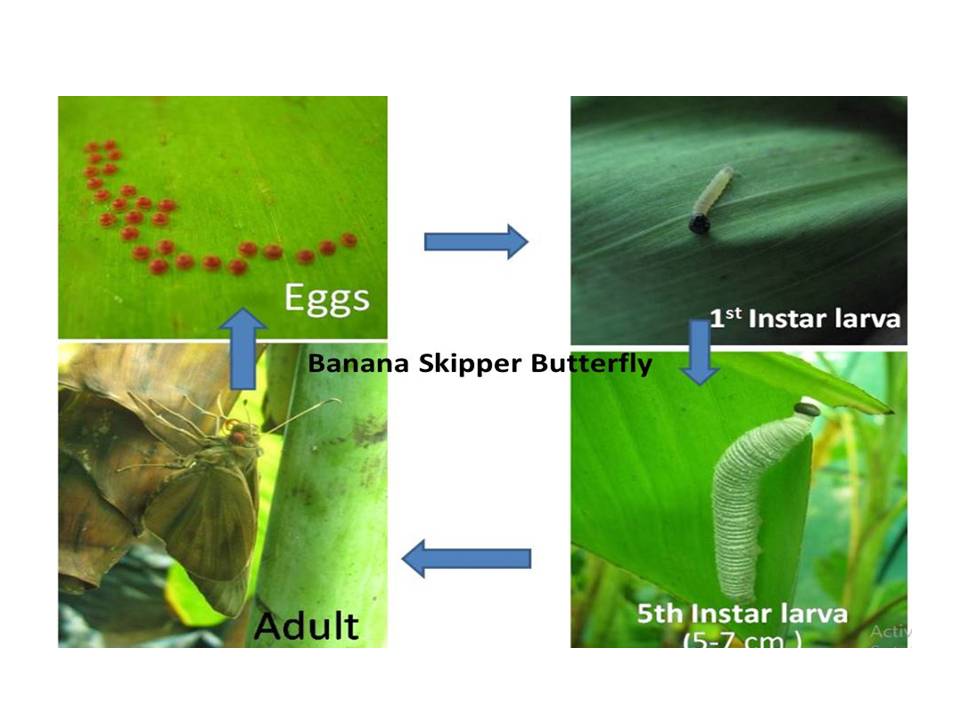
Entomopathogenic Nematodes (EPN) for the biological control of major weevil pests of banana
Entomopathogenic Nematodes (EPNs) are beneficial nematodes belonging to the Phylum Nematoda, that have the ability to parasitize and kill insects. These are microscopic, non-segmented, elongated round worms that are colourless and lack appendages. These nematodes are effectively used as biocontrol agents against a large number of insect pests belonging to various insect orders viz., Coleoptera, Lepidoptera, Hemiptera, Orthoptera etc.They are excellent candidates for being considered as a viable alternative to chemical insecticides, with zero adverse impact on humans, animals, birds, fishes or to the environment.
Two genera of EPN viz., Steinernema and Heterorhabditis have proven track record as excellent biocontrol agents.
Advantages of EPN
- Excellent active host seeking ability or foraging nature.
- Wide host range and quick knock down effect, bringing mortality to insect host within 24- 48 hours.
- Ability to survive long periods in soil or substrate.
- Tolerance to slow desiccation of the media.
- Easiness in mass production.
- High survival rate and long-term efficacy.
- Easy to apply, compatible with most insecticides and environmentally safe. Can be incorporated as a viable component in Integrated Pest Management (IPM).
Mass production, Formulation and Storage of EPN
Entomopathogenic nematodes can be mass produced in vivo and in vitro. The most commonly used insect host for in vivo production is the Greater wax moth, Galleria mellonella larvae because of its high susceptibility, amenable for rearing in semi synthetic diet and high yield. In vitro mass production is achieved in solid or liquid medium. It has advantage in terms of economy of scale over in vivo production. However in vivo culturing is the still most preferred technique for its easiness, provision for up scaling as per requirement, simpler handling techniques etc.
Uses
Though the use of EPN in India has been limited till now, few committed research works were being done at IARI, New Delhi, ICAR institutes and SAUs. But worldwide, over 80 species of entomopathogenic nematodes have been identified out of which 11 are commercialized. EPN can be used against soil insects, foliar insects, stem/bark borers etc., provided there is sufficient oxygen and water for the movement of nematodes. Very high or low temperature, UV radiation and accelerated desiccation kill EPNs.
Banana Research Station, Kannara (AICRP on Fruits) and Krishi Vigyan Kendra, Kollam under Kerala Agricultural University are producing EPN infected wax moth larval cadavers and supplying to farmers @ Rs.1.5/cadaver (Fig. 14). The cadavers are effective in managing banana weevils, root grubs of various crops, wood borers. IJs in liquid formulation with UV protectant and stickers are effective in managing foliar insects. Generally the dosage recommended is 10,000 cadavers / ha (2.5 billion IJs /ha). EPN can be applied as foliar spray, broadcasted, placed in target site or even through irrigation water.
Management of weevil pests of Banana
- Application of Heterorhabditis bacteriophora for the biological control of banana Pseudostem weevil (Odoiporus longicollis)
- Biological control of banana stem weevil (Odoiporus longicollis Oliv) in cv. Nendran can be successfully achieved by leaf axil application of EPN infected Galleria cadavers and use of stem trap swabbed with Heterorhabditis sp. @ 1x106 IJs/ml at 5th, 6th and 7th month after planting as a prophylactic control measure .
- If holes along with frass material or jelly like exudation are observed on pseudo stem, inject 20 ml of active infective juveniles (IJs) @ 1000 IJs/ml into the holes as a curative control measure ( Fig. 15).
- Application of Heterorhabditis bacteriophora on banana Rhizome weevil (Cosmopolites sordidus)
- Sucker treatment with Pseudomonas fluorescens @ 20 g/l + soil placement of cadaver infected with Entomopathogenic Nematode, Heterorhabditis bacteriophora @ 4 infected wax moth larvae /plant at planting, followed by two applications at, 2 and 5 months after planting is effective.
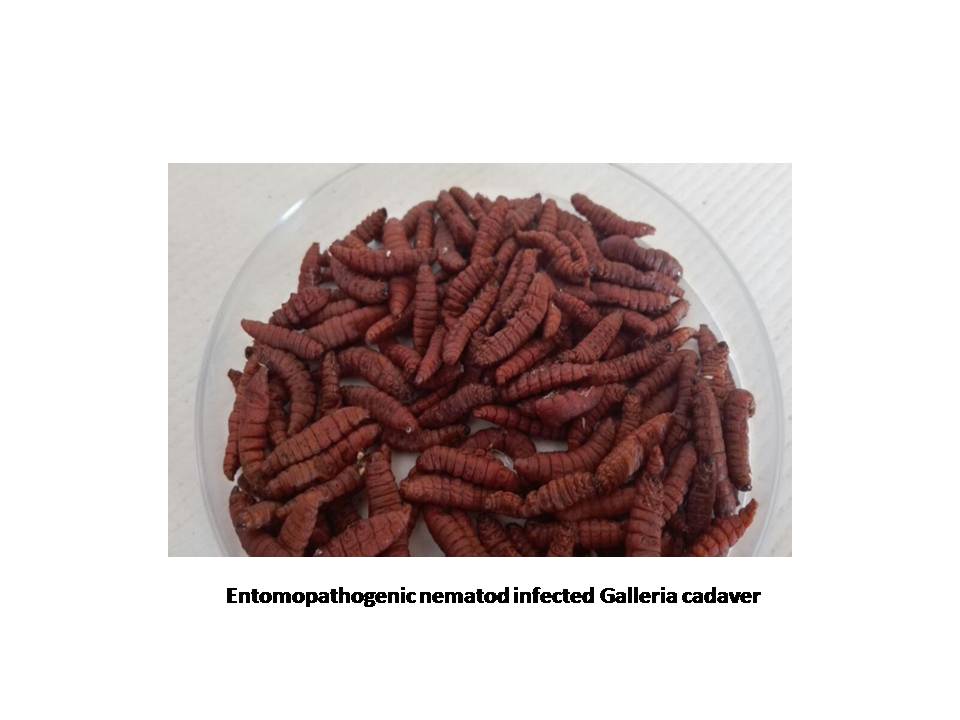
Management of Pseudostem weevil/Banana stem weevil (Odoiporous longicollis)
Pseudostem weevil is considered as the major pest of banana which causes substantial yield loss in banana cultivation and this was discovered from Ernakulam district in Kerala. As the name indicates the start of pseudostem weevil infestation commences from three and a half months after planting (MAP).Banana cultivars like Nendran, Chenkadali, Palayankodan, Poovan etc. are prone to its attack. Grubs without legs of nearly 1.5cm length with yellowish body and red head along with its adult beetles are deleterious to banana.
Mode of attack
Mated female beetles lay eggs with in air pockets of leaf sheaths and grubs emerge after one week.They bore in to the stem while feeding profusely and makes extensive galleries inside the plant stem. These galleries are filled with their excreta and chewed materials thus weakening the stem .Once they reach the inner pseudostem their attack causes irreversible plant damage. Initial symptoms include bore holes on the stem /sheath and sticky jell like exudation as attack progresses. Damage to inner core leads to weakening of stem and its breaking. If their attack progresses to base of the bunch, it leads to bunch drying and withering.
Management
Biological
- The field should be kept clean by removing plant materials including left over pseudostem after harvest as they may harbour different live stages of pest.
- Cut and remove weevil infested and severely damaged pseudostemand shred them into small pieces. They can be used for vermicomposting.
- Remove senile,leaf spot infected and hanging leaves that acts as refuge for adult beetles.
- Application of entomopathogenic fungus, Beauveriabassiana @ 20g/l of waterinto leaf axil and pseudostem is found effective.
- Adult beetles can be trapped using pseudostem trap @ 1 trap/40 plants. They can be prepared by taking harvested banana stem of 1 feet length and splitting them longitudinally.Swab the cut surface of longitudinal split traps with 20g Beauveriabassianaor Entomopathogenic nematode(EPN) (Heterorhabditisbacteriophora) infected Galleria cadavers and keep the other half over it fitting correctly.
- For prophylactic control of pseudostem weevil, leaf axil application of Entomopathogenic nematode(Heterorhabditisbacteriophora) infected cadaver @ 4 cadaver per plant at 5th,6th,7th month after plantingalong with using stem trap swabbed with Entomopathogenic Nematode @ 1x109infective juveniles(IJs)/trap 5th month after planting onwards.
- If holes along with frass material or jelly like exudations are observed on pseudostem, inject 20ml of active infective juveniles(IJs) of EPN @1000IJs/ml in to the holes as curative measure.
Chemical
- Apply Fipronil 5% SC@ 3ml/l or carbosulfan25EC @ 1.5ml/l on pseudostem and basal application at 5th,6thand 7th month after planting.
- In severe cases, for curative management, applychlorpyriphos 20 EC @ 2.5ml/l as pseudostem spray and basal drench.
Advantage
- 30-40% yield loss due to infestation can be avoided, saving the crop, resulting in realization of good yield.
- In addition to control PSB, other pest like rhizome weevil, plant parasitic nematodes and root mealy bug can be effectively controlled, thus avoiding the reapeated use of plamt protection chemicals.
- Adopting this technology timely and need basis will help to reduce monetary burden to the farmers.
- B:C Ratio - 2.85
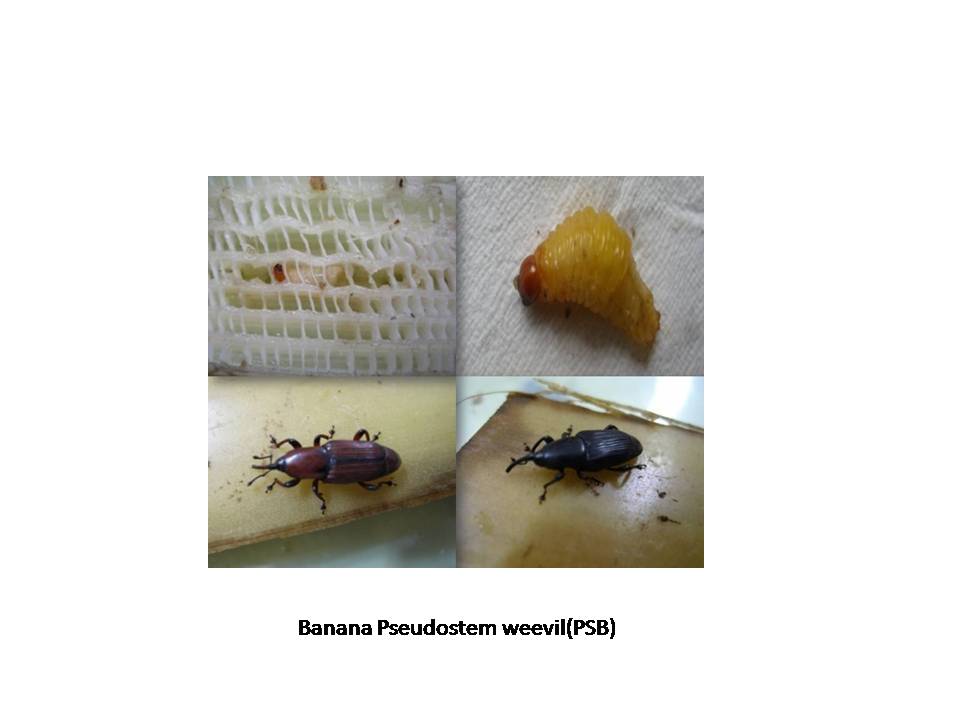
Management of Plant Parasitic Nematodes Associated with Banana
Major plant parasitic nematodes like Root knot nematode, Root Lesion Nematode, Burrowing Nematode, Spiral nematodes and cyst nematodes are most prevalent in banana growing tracts.
Mode of attack
The plant parasitic nematodes cause characteristic root galls, lesions or death of tissues resulting in damages and death of xylem vessels which impair the movement of water and nutrients. The above ground symptoms include stunted growth, formation of small and chlorotic leaves etc. as the microorganism live under the ground, the above ground symptoms will be usually mistaken as nutrient deficiency.
Management
Biological
- Growing cowpea ( trap crop for root knot nematodes) helps in reducing nematode population
- Raising Marigold, Tagetus patula (Antagonistic to nematodes) and incorporating in-situ after plucking flowers is most effective.
- Adding well decomposed farm yard manure@20t/ha to enrich soil to enhance beneficial nematode antagonistic microorganism.
- Application of Paecilomyces lilacinus@ 25g/m2 effectively reduced the nematode population
- Application of neem cake @ 250 g/clump at the time of planting followed by 250g after 3rd month and Growing Tagetus around the basin can effectively reduce the population of soil nematodes.
Chemical
- Application of cartap hydrochloride @ 10-20 g/m2 effectively reduced the nematode population, increased the plant growth and bunch weight.
Advantage
Prevent multiplication and spread of plant parasitic nematodes, a severe biotic constraint in banana cultivation. Adopting raising of cowpea and marigold as intercrop substantially enrich the soil, apart from controlling nematodes.
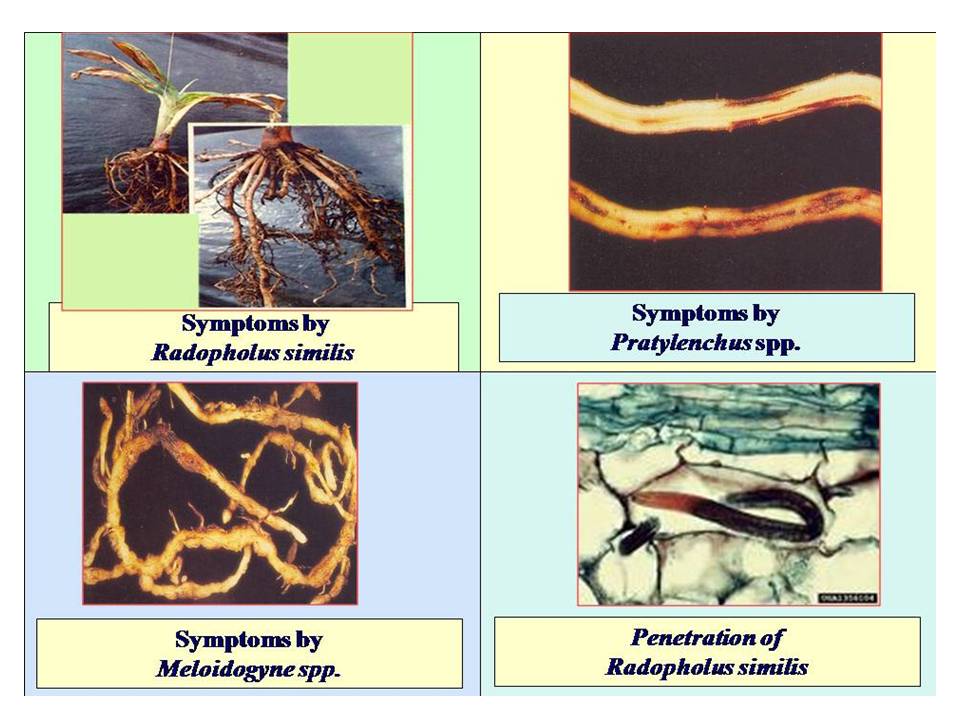
Banana variety Manjeri Nendran II
Nendran is the most popular and commercially cultivated banana variety in Kerala, occupying more than 50% of the area under cultivation. About 10 clones of nendran are being cultivated in the state, of which nedunendran is the most popular. The cultivar is characterized by low inherent yielding ability and susceptibility to pests and diseases like Eumusae leaf spot and pseudostem borer. Evaluation of promising clones of banana led to the identification of Manjeri Nendran II, as a promising clone of Nendran with higher yield and tolerance to pests and diseases.
UNIQUENESS OF THE TECHNOLOGY
- A superior french plantain selection with 27% additional yield than existing clone Nedunendran.
- Tolerant to Eumusae leaf spot and pseuodostem weevil.
- Plant height - 325cm
- Pseudostem girth - 50 cm
- Average bunch weight - 14 kg
- Hands per bunch - 6
- Fingers per bunch - 65
- Crop duration - 335 days
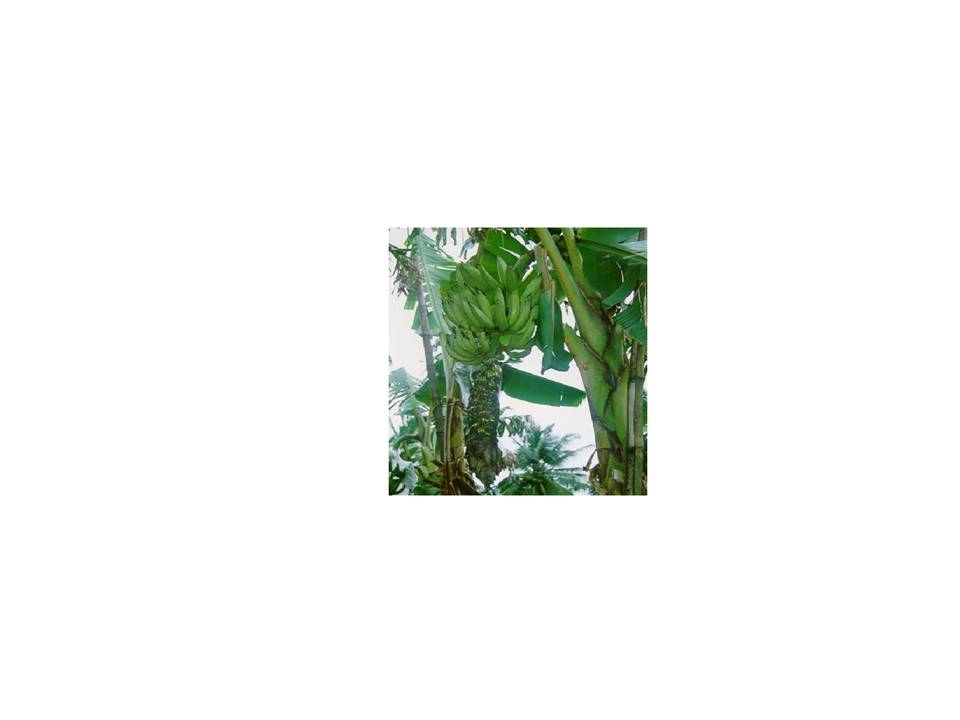
Production of quality planting material in banana through macropropagation
Bananas and plantains are vegetatively propagated through suckers. This is usually a very slow process, and produces small amounts of planting material that are likely to be contaminated with soil-borne pathogens, insect pests and nematodes. Non-availability of clean, true to type and disease free planting material is one of the most important limiting factor in banana cultivation. Planting materials produced through tissue culture are costlier and small and marginal farmers cannot afford the higher cost. Hence, macropropagation, a simple and farmer friendly method has been developed to bridge the gap in supply of healthy planting material at an affordable cost.

Management of Eumusae leaf spot disease
Eumusae leaf spot disease is a devastating banana disease found throughout in Kerala. The disease is caused by the fungus Mycospherella eumusae. The infection causes defoliation and as a result reduction of photosynthetic capacity of plants. The estimated yield loss due to the disease is 33-76%. The varieties Nendran, Grand Naine, Robusta, Dwarf Cavendish and Palayankodan are highly susceptible.
Symptoms: Appearance of light green narrow specks on the upper surface of the leaves, which enlarge to become dark brown elliptical spots with yellow halo. Later, the spots coalesce and entire leaves may dry up.
Technology:
1.Foliar spray of 0.1% Difenconazole + 10% Mineral oil at the initiation of disease and twice at 25 days interval.
2.Foliar spray offungicides viz., Azoxystrobin 0.1%, Tebuconazole 0.1% and Difenconazole 0.1 %
3.Use of biocontrol agent Pseudomonas fluorescens (5%) as sucker treatment plus foliar spray as spraying (2%) with vegetable oil (2.5ml/l) and baking soda (2.5g/l)
4.Foliar spray of cow’s urine (10%)
5.Foliar spray of petroleum based mineral oil (1%)
Advantage: By the adoption of the technology, the disease severity was reduced to 62% over control plot (without spray) and 50% over check fungicide (Carbendazim + Mancozeb).The benefit cost ratio of the technology is 2.8.
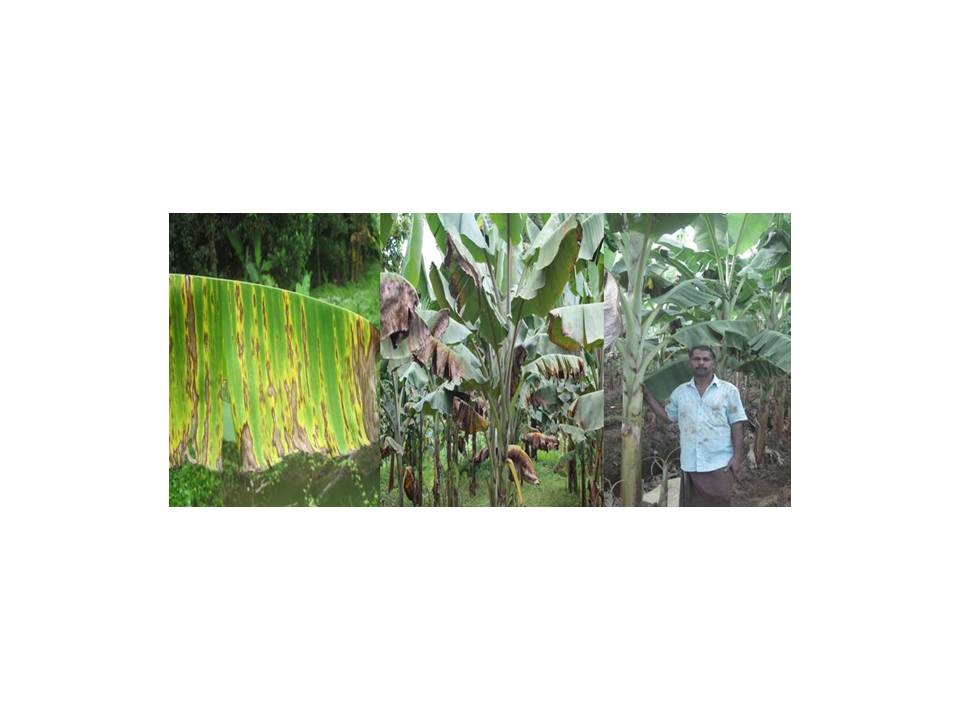
Management of Fusarium wilt disease
Fusarium wilt is a destructive disease caused by fungus Fusarium oxysporum f.sp cubense.The estimated yield loss due to the disease is 50-70% in susceptible varieties like Rasthali (Poovan), Njalipoovan, Monthan and Kadali.
Symptoms: The diseased plants show yellowing and wilting of outermost leaves, followed by longitudinal splitting of the pseudostem. Severely diseased plants will not flower. The pseudostem and rhizome of such plants will show a ring of reddish brown discoloration.
Technology: Application of Neem cake @ 250g/plant + sucker dipping in Carbendazim (0.2%) for 30 min + soil drenching of Carbendazim (0.2%) during 2,4 & 6 months after planting + pseudostem injection of Carbendazim (2%) during 3,5 & 7 months.
Advantage: By the adoption of the technology, the disease severity was reduced by 26% and yield was enhanced by 62 % over. Over conventional practice, the per cent disease index was reduced by 10% and yield was enhanced by 22%.The benefit cost ratio of the technology is 2.0.
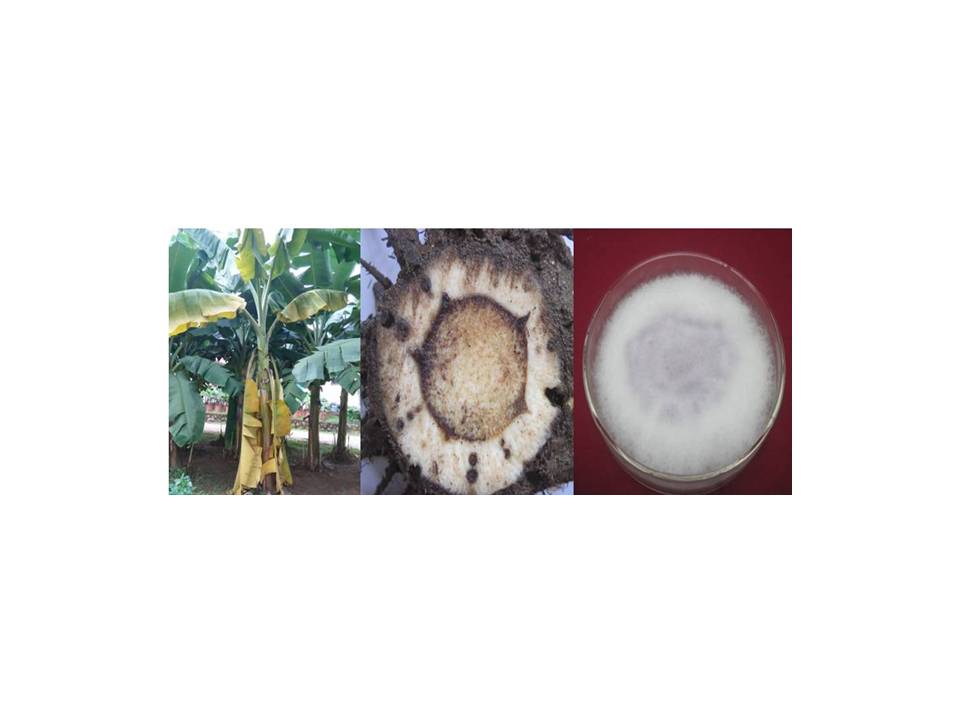
stage wise nutrient requirement in banana cv. Nendran
Banana crop exhausts major and micronutrients from the soil in large quantities and the soil require a continuous replenishment. In conventional methods, fertilizers are applied in 2 splits at 2nd and 4th months after planting. It is estimated that under the tropical conditions of Kerala, the efficiency of applied nitrogen is less than 50%, and for potassium it is somewhere around 40%. Losses of nitrogen are mainly due to leaching, runoff and volatile losses of ammonia. But for potassium, it is largely attributed to leaching and runoff. Therefore to ensure regular availability of nitrogen and potassium throughout the growth period and also to minimize its wastage, N and K fertilizers should be applied in small split doses at short intervals of time. The time of application of fertilizer is also equally important and for getting better results in terms of higher yield and productivity. Hence a stage wise split application of N and K fertilizers is recommended for banana cv. Nendran for Kerala.
Technology
Application of 100% RDF (190 : 115 : 300 g N, P2O5 and K2O) in respect of nitrogen and potassium at 10:10, 40:20, 30:30, 20:40 at 3rd, 5th , 7th, 9th MAP after planting is recommended for the maximum productivity of banana cv. Nendran.
Uniqueness of the technology
- Split application of nitrogen and potassium increases the leaf nutrient status, uptake and distribution of nutrients and ultimately results in better growth and yield.
- Increased fertilizer use efficiency and reduces wastage of fertilizers.
- Reduces degradation of soil health and environmental pollution.
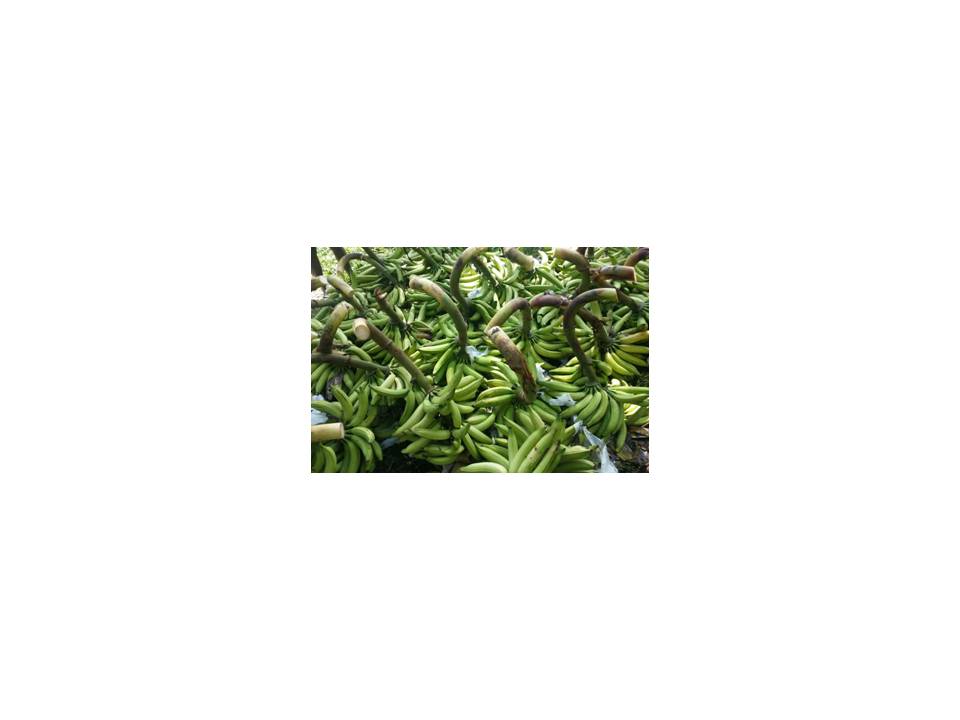
Organic nutrient schedule in banana cv. Nendran
Nendran is the most popular and commercially cultivated banana variety in Kerala, occupying more than 50% of the area under cultivation. Being an exhaustive crop, the cultivation of this variety involves the application of large amount of inorganic fertilizers as well as indiscriminate use of chemical pesticides. Global trade in organic foods especially fruits has grown tremendously over the past few years. The rising popularity of organic foods has generated demand for increasing the production of organic Nendran in the state. Research on the replacement of inorganic fertilizers with organic substitutes without compromising on yield and productivity has led to the development of an organic nutrient schedule in Nendran banana.
Technology
Application of 200 g N, 200 g K2O per plant in terms of 10 kg FYM, 1.25 kg neem cake, along with 25 g of Arbuscular Mychorizzal fungi, 50g each of Azospirillum, Phosphorus solubilising bacteria and T. harzianum as basal application and along with triple green manuring with cow pea, application of vermicompost (5kg/plant) three months after planting and also wood ash (1.75 kg/plant) at 5 months after planting is recommended for sustainable organic production in banana in major commercial banana cultivating states for improving quality in terms of shelf of the fruit and improving soil health.
Uniqueness of the technology
- Sustainable organic production of Nendran banana.
- Improves the soil health, including biodiversity, biological cycles and soil biological activity.
- Water management and pollution reduction due to organic fertilizers.
- Climate change mitigation by reducing fossil fuel consumption and implementing carbon sequestration mechanisms (returning crop residues to the soil and integration of nitrogen-fixing legumes).




